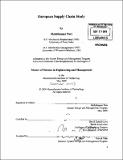European supply chain study
Author(s)
Puri, Mohitkumar
DownloadFull printable version (11.40Mb)
Other Contributors
System Design and Management Program.
Advisor
David Simchi-Levi.
Terms of use
Metadata
Show full item recordAbstract
Introduction: Supply chain management has been defined as, "..a set of approaches utilized to efficiently integrate suppliers, manufacturers, warehouses and stores, so that merchandise is produced and distributed at the right quantities, to the right locations and at the right time, in order to minimize system-wide costs.... satisfying service level requirements.. " -- ".. integration of activities ..through improved supply chain relationships to achieve sustainable competitive advantage.. " -- "..coordination and collaboration with channel partners.. coordination of process and activities.. " [53] "..from the ore mine to the trash can... the production and distribution network that encompasses the sourcing, manufacturing, transportation, commercialization, distribution, consumption, and disposal of goods.. " -- "...flow of requirement information from buyer to seller which triggers all later activities, the movement of goods from sellers to buyers, transfer of ownership rights from seller to buyer and payment from buyer to seller. " The above definitions offer a broad spectrum of supply chain orientation and management choices available to companies. They could vary from a transactional orientation that is focused on low cost acquisition; to one where stronger relationships are established with key suppliers and customers in an effort to optimize and capture synergies; onward to a partnership orientation that is focused on supporting mutual goals for a sustainable competitive advantage. Making the right choice is essential. It can have a significant impact on a company's balance sheet and income statement. GSCF and SCOR are two popular process frameworks in supply chain management [36]. Corporate strategy is the starting point of the GSCF framework, with the operational aspects of customer relationship management and supplier relationship management linked to the strategy. Its process metrics are related to EVA. On the other hand, the SCOR framework focuses on transactional efficiency by integrating operational activities such as purchasing, operations, and logistics. It benchmarks process metrics to improve operational efficiency.
Description
Thesis (S.M.)--Massachusetts Institute of Technology, Engineering Systems Division, System Design and Management Program, 2009. Cataloged from PDF version of thesis. Includes bibliographical references (p. 71-77).
Date issued
2009Department
System Design and Management Program.; Massachusetts Institute of Technology. Engineering Systems DivisionPublisher
Massachusetts Institute of Technology
Keywords
Engineering Systems Division., System Design and Management Program.